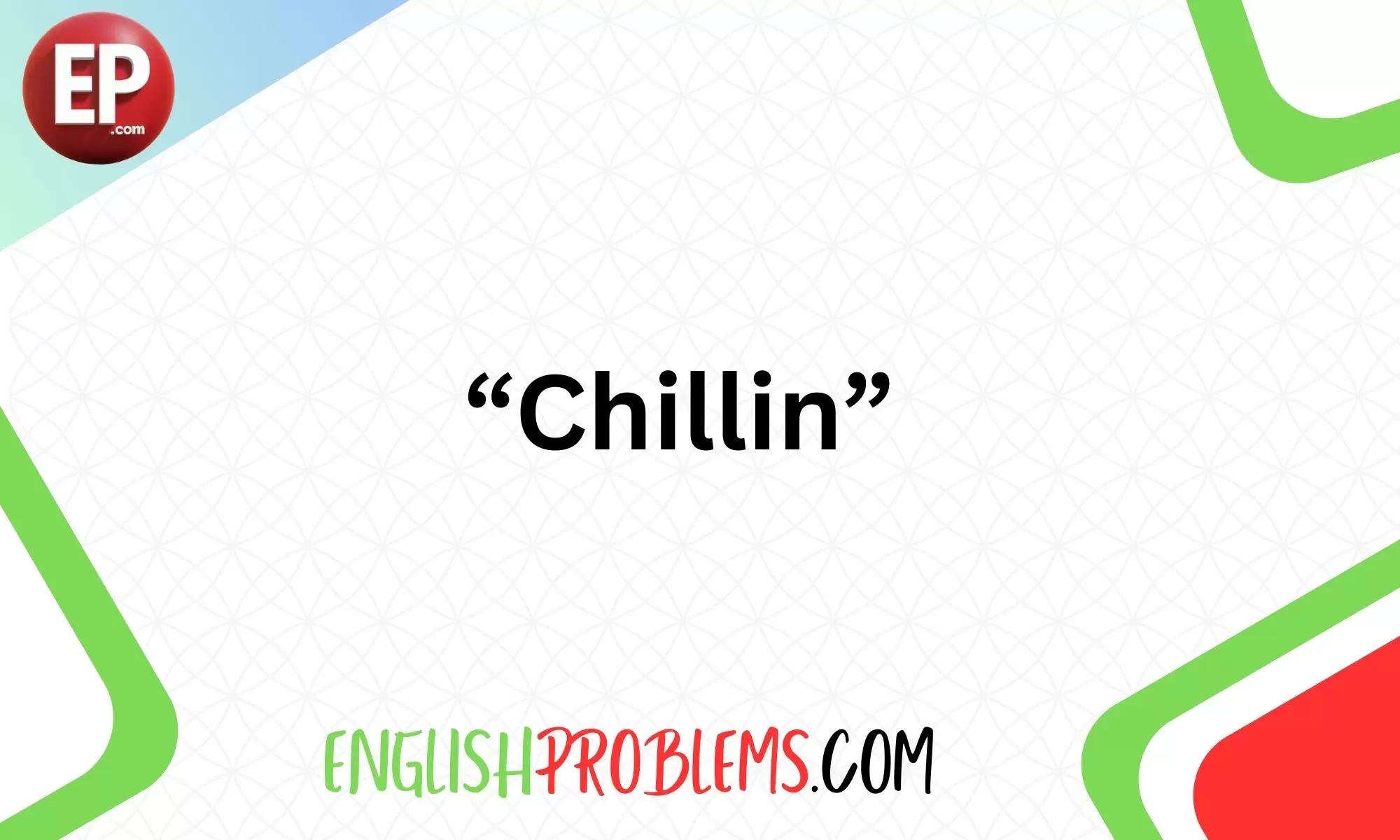The term “chillin’” is a cornerstone of contemporary slang, often used to describe a relaxed state or activity. This blog post explores the various facets of “chillin’,” from its definition and origins to its cultural significance and usage in media.
By delving into the evolution of the term and its nuances, we aim to provide a comprehensive understanding of this popular slang.
Definition of ‘Chillin’
“Chillin’” is an informal term used to describe a state of relaxation or leisure. It implies a laid-back attitude and often denotes engaging in activities that are stress-free and enjoyable. Here’s a closer look at its meaning:
- Relaxation: To “chill” means to take it easy and unwind.
- Leisure Activities: It often refers to casual activities done in a relaxed manner, such as hanging out with friends or lounging at home.
For example, if someone says, “I’m just chillin’ at home,” they mean they are relaxing and not engaging in any strenuous activity.
The Evolution and Origin of ‘Chillin’
The evolution of “chillin’” is rooted in the broader history of slang and informal language. Here’s a breakdown of its development:
- Origins: The term “chill” has its roots in Old English, where it originally referred to coolness or coldness. Over time, it evolved to represent a more relaxed state.
- 1980s and 1990s: The slang “chillin’” became popular in American urban culture during these decades, influenced by hip-hop and rap music.
- Modern Usage: Today, “chillin’” is widely accepted in informal contexts across various demographics.
The Role of the ‘-ing’ Suffix in Informal American Slang
The use of the ‘-ing’ suffix in slang is a common practice that transforms verbs into informal, ongoing actions. Here’s why it’s significant:
- Ongoing Action: The suffix ‘-ing’ implies that the action is continuous, which fits well with the idea of being in a relaxed state.
- Informality: It contributes to the casual and conversational tone of the slang.
Other examples include “partying,” “hanging,” and “vibing.”
From Temperature to Slang: The Journey of ‘Chill’
The term “chill” originally referred to a low temperature. Its transition to slang involved a shift in meaning:
- Literal Chill: Initially, “chill” described a drop in temperature, as in “a chill in the air.”
- Metaphorical Chill: The metaphorical use of “chill” to describe a relaxed state emerged in the late 20th century. It began to signify a laid-back attitude rather than a physical sensation.
Cultural Significance of ‘Chillin’
“Chillin’” holds cultural significance across various contexts:
- Urban Culture: In urban environments, “chillin’” is associated with a laid-back lifestyle and often features in music and street language.
- Social Dynamics: It reflects a cultural shift toward valuing relaxation and downtime as integral to well-being.
Everyday Usage of ‘Chillin’
The term “chillin’” is used in a variety of everyday scenarios:
- Social Settings: “Let’s chill at the park” means to spend time together in a relaxed manner.
- Solo Activities: “I’m just chillin’ at home” indicates a state of individual relaxation.
Examples in Different Settings
- Friends: “We spent the afternoon chillin’ and playing video games.”
- Family: “On weekends, I enjoy chillin’ with my family and catching up on TV shows.”
‘Chillin’ in Media and Popular Culture
Media and popular culture have played a significant role in popularizing “chillin’”:
- Music: The term is frequently used in lyrics and titles. For instance, songs like “Chillin’ Like a Villain” by Selena Gomez incorporate the term to convey a carefree attitude.
- Movies and TV Shows: Characters in popular films and series often use “chillin’” to describe their laid-back moments.
Media Impact
- Music Influence: Artists like Kid Cudi and Drake use “chillin’” to reflect a relaxed lifestyle in their songs.
- On-Screen Portrayals: Films like “Ferris Bueller’s Day Off” and TV shows like “Friends” feature scenes where characters are depicted as “chillin’.”
Analyzing ‘Chillin’ in Popular Music Lyrics
Music lyrics often reflect and reinforce slang usage. Here’s how “chillin’” is represented:
- Repetition: The term is used frequently to emphasize a relaxed state. For example, in Drake’s song “Too Good,” the lyrics talk about “chillin’” as part of a carefree lifestyle.
- Cultural Reflection: Lyrics that mention “chillin’” often capture the essence of modern, relaxed living.
On-Screen Characters and ‘Chillin’
In movies and TV shows, “chillin’” is depicted through various characters and scenarios:
- Relaxed Characters: Films like “Dazed and Confused” showcase characters who embody the “chillin’” lifestyle, spending time with friends in a carefree manner.
- Cultural Reflection: These portrayals influence public perception and usage of the term.
Different Contexts and Nuances of ‘Chillin’
The context in which “chillin’” is used can alter its meaning:
- Social Contexts:
- With Friends: Refers to casual, social interactions. Example: “We’re just chillin’ and watching a movie.”
- Alone: Indicates solitary relaxation. Example: “I love chillin’ with a good book on weekends.”
Nuances in Meaning
- Casual vs. Serious: “Chillin’” can indicate a serious form of relaxation or a more casual, nonchalant attitude.
- Intensity: The intensity of “chillin’” can vary from a complete unwind to a more active, but still relaxed, activity.
‘Chillin’ vs. ‘Chilling’: Understanding the Differences
Understanding the difference between “chillin’” and “chilling” involves a look at their grammatical and contextual use:
- ‘Chillin’: Informal, slang form often used in casual conversation.
- ‘Chilling’: Can be more formal and is used in a broader range of contexts.
Grammatical and Semantic Differences
- Grammar: The ‘-ing’ form (chilling) is used in both formal and informal contexts, while ‘chillin’ is typically more casual.
- Usage Examples:
- ‘Chillin’: “We’re just chillin’ at the beach.”
- ‘Chilling’: “I’m chilling with my book.”
The Grammatical Perspective of ‘Chillin’ and ‘Chilling’
Grammatical rules play a role in the use of slang terms:
- Formal vs. Informal: “Chilling” can be used in both formal and informal settings, whereas “chillin’” is more restricted to informal conversations.
- Language Evolution: The informal nature of “chillin’” reflects the evolving nature of language and slang.
Practical Usage Tips
Here are some tips for using “chillin’” effectively:
- Context: Use “chillin’” in casual, informal settings with friends and family.
- Avoid Overuse: Don’t use “chillin’” in formal writing or professional contexts where more formal language is expected.
- Clarify Meaning: Ensure that the context makes the meaning of “chillin’” clear to avoid misunderstandings.
Conclusion
“Chillin’” is more than just a slang term; it reflects a cultural attitude towards relaxation and leisure. From its origins and evolution to its representation in media and popular culture, understanding “chillin’” provides insights into how language and culture intersect.
By recognizing the nuances and proper usage of the term, we can appreciate its role in modern communication and social dynamics.
This blog post is designed to be comprehensive and engaging, offering a thorough exploration of “chillin’” while adhering to a conversational and easy-to-read style.

Matthew Porter brings a wealth of knowledge and a vibrant enthusiasm for teaching English to the table. His innovative approach and creative explanations make even the most challenging language concepts accessible and fun. Matthew’s dedication to helping others achieve fluency is evident in every piece he writes.










